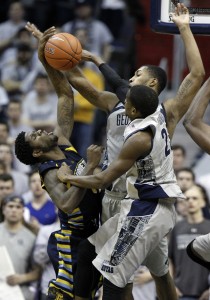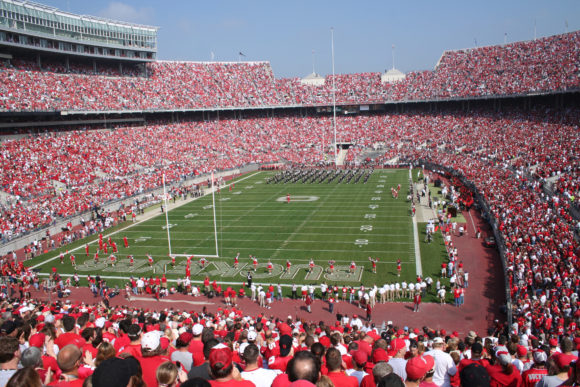An Indiana appeals court has sided with a group of insurers, saying they are not required to provide $25 million in excess coverage for an underlying lawsuit against the National Collegiate Athletic Association (NCAA) over rules the association’s member colleges and universities use in financially assisting student athletes.
On appeal from the Marion Superior Court, the Court of Appeals of Indiana considered one issue in National Collegiate Athletic Association v. Ace American Insurance, et al, that is: whether “the Related Wrongful Acts Exclusion in the NCAA insurance policies bars coverage for the NCAA” in a lawsuit that essentially covers the same ground as one that the NCAA fought in an earlier case.
The case for which NCCA currently is seeking coverage is Jenkins et al. v. Nat’l Collegiate Athletic Assoc., a class action complaint filed in March 17, 2014. But the dispute over whether the NCAA’s insurance policies allow for coverage in Jenkins extends back to an earlier class action complaint that addressed similar issues: White v. Nat’l Collegiate Athletic Ass’n, Case No. CV06-0999 (C.D. Cal.) that was settled in California in 2006.
White contested the NCAA’s policy of providing “student-athlete scholarships, or grants-in-aid, [that] covered only tuition and fees, room and board, and required books,” compensation that the class action maintained was “was less than the actual cost of attendance.” It sought additional financial aid for “supplies, transportation, and other expenses related to attendance at the institution,” including health insurance.
Major college football and basketball programs generate billion in annual revenues for the NCAA and its institutions, but students athletes are not allowed a share of the revenues, White maintained. “The NCAA and its member institutions have short-changed student-athletes by imposing an artificial cap on the amount of financial aid any student-athlete may receive in the form of an athletic scholarship, or grant-in-aid. The artificial cap on financial aid is set below the full amount of the full cost of attendance that any student would incur to attend the relevant colleges and universities,” White stated.
In White, the plaintiffs were male college football and basketball players who received athletic-based financial aid between Feb. 17, 2002, and Aug. 5, 2008, when the final judgment in the case was entered. A settlement in the case resulted in a decrease in the gap between the value of the athletic scholarship and the actual cost to the student of attending the college or university. The settlement also established a $218 million Student-Athlete Opportunity Fund that institutions could tap to provide additional aid to students with financial need. Schools could also offer health and accident insurance to student athletes following the White settlement.

The Jenkins lawsuit takes up where White left off. It also alleges that the NCAA and its member institutions make billions of dollars from their athletic programs without enabling the student athletes to share in those revenues.
Jenkins alleges that the NCAA and its members “have entered into what amounts to cartel agreements with the avowed purpose and effect of placing a ceiling on the compensation that may be paid to those players for their services. Those restrictions are pernicious, a blatant violation of the antitrust laws, have no legitimate pro-competitive justification, and should now be struck down and enjoined.”
In the written opinion of the court, Judge Patricia A. Riley explained: “Jenkins contested, as illegal under the Sherman Act, all NCAA rules that prohibit, cap, or otherwise limit the remuneration that players may receive for their athletic services.”
Like White, the Jenkins lawsuit was filed on behalf of student football and basketball players. “Unlike White, Jenkins‘ declaratory and injunctive relief sought to enjoin the NCAA and the other defendants from imposing any restrictions on what money or other benefits could be offered to student athletes.”
The Policies
For the period covering the White lawsuit, the NCAA held a primary and two excess polices from National Union Fire Insurance Company (National Fire) for the coverage period of Sept. 30, 2005, to Sept. 30, 2006. One of the excess policies was “a follow form policy, indicating that its coverage generally applies according to the same terms and conditions” after the primary policy is exhausted, the written opinion states.
Coverage under the primary policy “was limited to Claims ‘first made’ and reported during the policy period,” and covered losses from a claim of alleged or actual wrongful act of the NCAA. The National Union Fire policy also states that “any Claim which is subsequently made against the Insureds and reported to the Insurer alleging, arising out of, based upon or attributable to the facts alleged in the Claim for which such notice has been given, or alleging any Wrongful Act which is the same as or related to any Wrongful Act alleged in the Claim of which such notice has been given, shall be considered made at the time such notice was given.”
During the period of Sept. 30, 2012, to Sept. 30, 2014, the time period that is applicable to the Jenkins lawsuit, the NCAA’s primary policy was issued by XL Specialty Insurance Company (XL). Excess policies “were issued by FIC (for an amount of $10 million in excess of $20 million), by Illinois National (for an amount of 10 million in excess of $30 million), and by Westchester (for an amount of $5 million in excess of $40 million),” the opinion states.
Like the earlier National Union policy, XL’s policy also covered losses for claims first made and reported during the policy period for any actual or alleged wrongful act of the NCAA, and the 2012-2014 excess policies followed form.
XL’s policy included a “Related Wrongful Acts Exclusion” that denies insurer liability for a claim “alleging, arising out of, based upon or attributable to the facts alleged, or to the same or Related Wrongful Act alleged or contained, in any Claim which has been reported, or in any circumstance of which notice has been given before the inception date of this policy, under any other management liability insurance policy, directors and officers liability insurance policy or any similar insurance policy of which this policy is a renewal or replacement or which it may succeed in time[.]”
XL’s policy defines related wrongful acts as ones that “are the same, related or continuous, or Wrongful Acts which arise from a common nucleus of facts. Claims can allege Related Wrongful Acts regardless of whether such Claims involve the same or different claimants, Insureds or legal causes of action.”
In April 2014, XL denied the NCAA’s claim for coverage for Jenkins, citing the Related Wrongful Acts Exclusion, and stating that the “wrongful acts” described in Jenkins are the same as those that were challenged in White. XL maintained that the claims made in Jenkins were essentially first made in February 2006 when White was filed.
In January 2016, NCAA filed for declaratory judgment damages against XL and the excess insurers. Prior to the trial court’s ruling, Ace American Insurance Company and several other insurers were added as addition defendants. A settlement also was reached between XL and the NCAA, and XL was dismissed from the action.
In June 2019, the trial court issued a judgment favoring the excess insurers, stating that the “Related Wrongful Acts and prior notice provisions are unambiguous, the underlying claims are clearly all against one wrongful act … first made in the White action, and coverage is barred under the policies.”
Considering the NCAA’s appeal of the trial court’s finding, the Indiana Court of Appeals was unconvinced by NCAA’s argument that the Related Wrongful Acts exclusion is overly broad and ambiguous and if “applied literally, the provision’s overbroad nature would negate virtually all coverage.” Alternatively, the NCAA argued that the wrongful act claimed in Jenkins differs from that of White, “is unrelated and unconnected, and therefore coverage falls within the terms of the 2012-2014 Primary Policy.”
The appeals court, however, found the wrongful acts claimed in “White and Jenkins are connected through [NCAA’s] Bylaw 15 and stem from a common nucleus of facts—the scholarship scheme imposed on student-athletes.”
The appeals court on July 15, issued its written opinion affirming the trial court’s summary judgement in favor of the insurers.
Topics Lawsuits Carriers Liability Claims Excess Surplus Education Universities
Was this article valuable?
Here are more articles you may enjoy.



 Woman Used Photos from Another Person in State Farm Claim, NCDOI Says
Woman Used Photos from Another Person in State Farm Claim, NCDOI Says  Elon Musk Beats $500 Million Severance Lawsuit by Fired Twitter Workers
Elon Musk Beats $500 Million Severance Lawsuit by Fired Twitter Workers  Deere Retreats From Diversity Measures After Online Attacks
Deere Retreats From Diversity Measures After Online Attacks  Allstate Seeking 34% Rate Hike on California Homeowners Insurance
Allstate Seeking 34% Rate Hike on California Homeowners Insurance 

